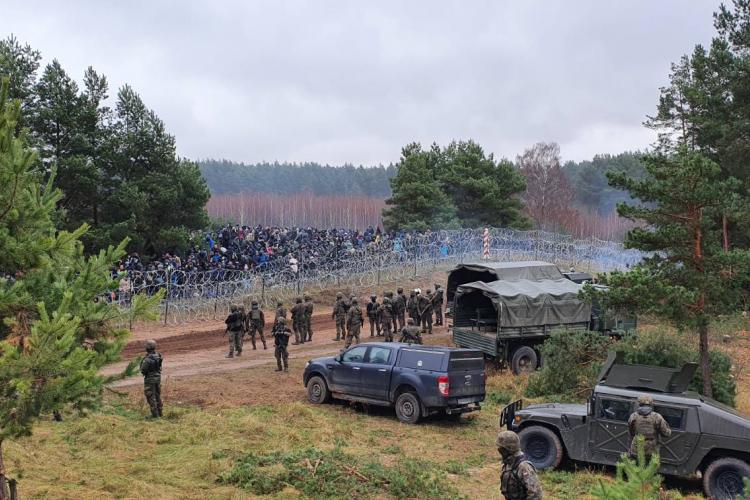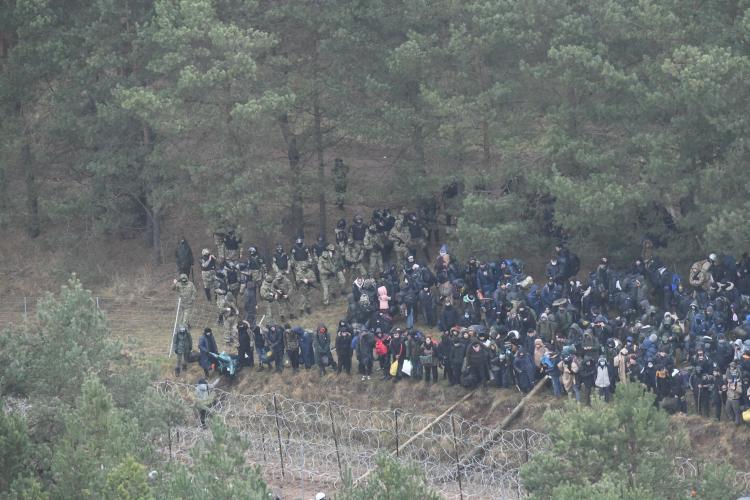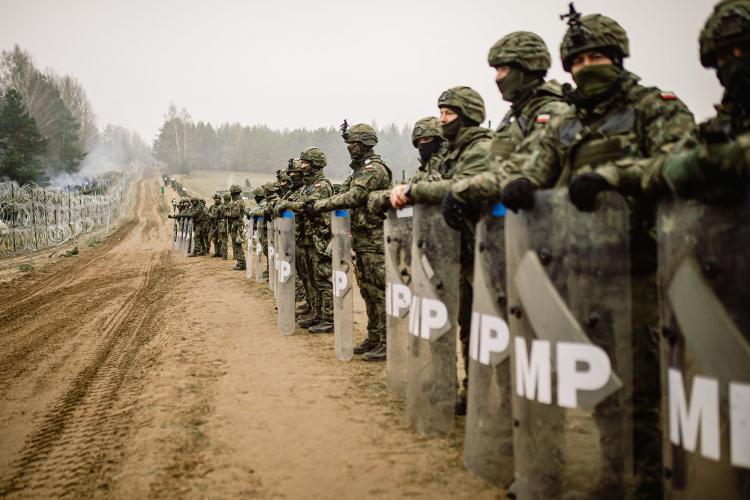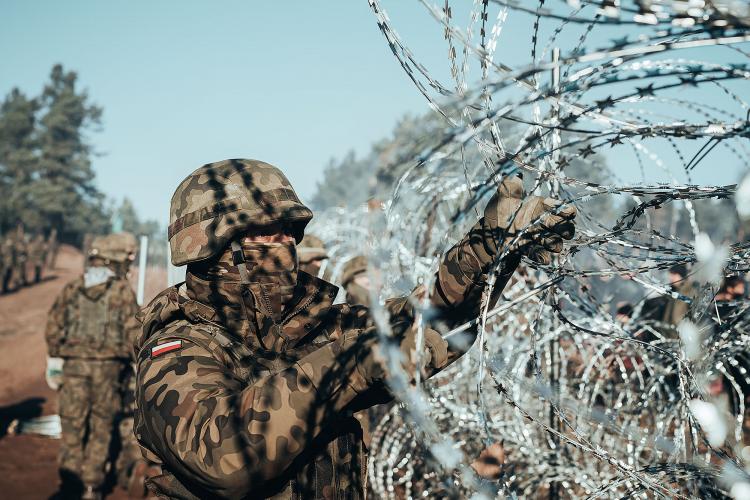The Dangerous Politics of Framing: The Situation at the Polish-Belarusian Border
Posted:
Time to read:
Guest post by Grażyna Baranowska, Begüm Başdaş and Natalie Welfens (postdoctoral researchers at the Centre for Fundamental Rights (CFR), Hertie School of Governance). Grażyna leads a Marie Skłodowska-Curie Postdoctoral project on missing migrants (MIRO). Begüm’s research project ‘In the Making of New Europe: Embodied Politics of Borderlands and Refugee Resilience’ examines EU borderlands in Greece and the Balkan routes. As a researcher in the ERC project ‘Refugees are Migrants: Refugee Mobility, Recognition and Rights’, Natalie investigates categorisation practices in refugee resettlement.

Since August 2021, hundreds of people on the move have attempted, some of them successfully, to enter the EU by crossing the border from Belarus to Poland. At least thirteen died. Politicians and the media have discussed the events largely in a language of warfare, blackmailing and diplomatic crisis. In this blog post, we argue that this framing has political implications, as it obscures the deadlock of EU asylum policies, the legal obligations that should, in principle, apply, and the rights and needs of people on the move. We conclude that the overall framing of events also crucially shapes what gets proposed as possible solutions, and what does not.
The situation: How has it all started?
The complex situation on the Polish-Belarusian border started in August 2021, when groups of people tried to cross over to Poland from Belarus. In particular, 32 Afghans were pushed back to Belarus by Polish forces and stranded in the no-man’s land between the two countries, near the Polish village of Usnarz Górny. Polish border guards refused their entry and Belarus would not allow them to return. The European Court of Human Rights (ECtHR) ordered interim measures on the 25 August 2021 to provide people with food, water, clothing, medical care, and temporary shelter, which Poland failed to comply with.
Since August, at least 13 people have died due to the harsh conditions, with hypothermia and starvation being the leading causes. On 2nd September, Poland declared a State of Emergency at its borders with Belarus and barred journalists, NGOs, and medical aid from entering the area. This makes it extremely difficult to report potential human rights violations in the area, including pushbacks. The events escalated on 8th November, when Belarusian authorities pushed around 1.000 people on the move towards the Polish border, to which Poland responded by deploying additional border guards, police, and military in the region. People who tried to cross to Polish territories were dispersed with tear gas and water cannons. Belarus relocated most people camped at the border to a nearby warehouse releasing the immediate tension. While some returned to their home countries, many are still trying to cross to EU territories to seek protection.

The dominant framing: Weaponization of Migration and Warfare
In European media, the situation gets frequently portrayed as a diplomatic conflict and as a new form of warfare, in which people on the move are `weaponized´. Major international newspapers largely agree on a narrative where Lukashenko, actively organizes a campaign to invite refugees from Iraq, Afghanistan and Syria to come to Belarus with tourist visas and takes them to the borders of Poland, Lithuania, and Latvia.
The Polish government as well as other European leaders have described this tactic as “hybrid attack”, “weaponized migration” and “human trafficking”. A recent caricature with the title “Lukaschenko’s attack on Europe” in the German newspaper Der Tagesspiegel illustrated this with a Kalashnikov that uses people as bullets. The president of the European Commission, Ursula von der Leyen defined the events at the Poland-Belarus border as a “hybrid attack, not a migration crisis.”
We argue it is neither. Evidently, incentivizing people to move based on wrong promises needs to be called out and condemned. Yet, von der Leyen’s statement also points to the main issue with how the events at the border are being portrayed: as events that are not about migration. Thereby, we argue, the debate obscures a number of aspects that are centrally shaping the situation at the Polish-Belarussian border: (1) the deadlock of EU`s migration and asylum regime; (2) the legal obligations on the ground; (3) the rights and needs of people on the move.
Obscuring the deadlock of EU’s migration and asylum system
Clearly, Lukashenko seeks to pressure the EU and its Member States. Yet, the fact that the EU remains vulnerable to such political pressures calls for a more profound analysis of what makes the regular occurrence of such situations possible in the first place: the deadlock of the EU’s migration and asylum system and, as a consequence, the dependency on externalized migration control to third countries.
Since the EU’s long summer of migration of 2015, the EU’s and its Member States’ migration and asylum policies have mainly focused on keeping the number of arrivals to the EU low. With the reform of the Common European Asylum System (CEAS) being in a deadlock for years, the EU and its Member States stepped up their efforts to externalize border control through migration deals with third countries, such as the EU-Turkey Statement of 2016.
The construction of a threatening narrative that large numbers of people are trying to enter EU, almost irrespective of their entitlement to protection, is at the same time what drives such deal making and what constitutes EU’s weak spot in the eyes of its partners. Staging what Nicolas de Genova calls a “border spectacle” then works as an effective tactic for other countries to trigger the EU and at the same time highlights the fragility of this policy approach. This is nothing new. Over a decade, countries such as Libya, Morocco, and Turkey have used similar tactics to pressure the EU. As long as there is no functioning EU internal system of responsibility sharing and reforms of the Common European Asylum System, including the Dublin system, do not move forward, the Union will remain easily pressured by the authoritarian leaders it so heavily relies on to halt arrivals.
Clearly, it takes two to tango. Belarus is indeed responsible for serious human rights violations. But the EU, instead of learning from past experiences, actively participates in warmongering narratives, allows authoritarian regimes’ efforts to “destabilize” the EU through migration and criminalizes people on the move, rather than sending a clear message by adhering to its values of rule of law.

Obscuring legal obligations
The politically complex situation does not however influence the legal situation on the ground. Regarding people who have crossed the border into Poland and asked for asylum, Poland’s obligations are crystal-clear: the asylum claims need to be processed and those who have submitted their claims cannot be returned to another country – including their country of origin –, as long as their asylum claims are being processed. While those obligations do not apply in the same manner to people who have not crossed the border, we cannot assess how many of those trapped in Belarus were pushed back by Poland in violation of international law. Poland also has obligations with regards to the people who have entered Polish territory, but who have been returned to Belarus without their asylum claims being processed. As has been widely reported, Poland is not only pushing people back in violation of international law, but also has legalized the practice in domestic law.
Obscuring the rights and needs of people on the move
In the current discourse, the mobility of people gets exclusively discussed in the criminalizing frames of “state-led smuggling” and “human trafficking”. First, this framing obscures that, once on EU territory, people have the right to have their asylum claim processed and are protected against refoulement. Second, the “weaponized migration” discourse denies people’s agency and contributes to an image of migrants as passive playthings in a political power game. It depicts people as objects that can be carried, pulled, and pushed, but not as human beings who have rights. What this sidelines, however, is the question why people are there, why they took the risk and whether they might be entitled to protection.

Conclusion
As the “hybrid warfare” and “weaponized migration” rhetoric dominates the understanding of the current situation at the borders of Poland and Belarus, the EU’s response to resolve the tensions continues to repeat the mistakes of the past – such as, more sanctions against Belarus, pressuring third country airlines into agreements to block travel routes, further negotiations with countries of origin and transit to return people from Belarus or efforts to externalize and direct asylum application processes to third countries. The other and more imminent factors at play, commitments to EU’s legal obligations, guarantees of access to asylum procedures, and ensuring the basic rights of people on the move, get paid lip service at best. This highlights the politics of framing the situation at the Polish-Belarusian border in particular ways, which foregrounds some but obscures other aspects. What this shows is that this situation is neither a “migration crisis” nor “hybrid warfare”. Such framings undermine a focus on migration and asylum policy making, the rule of law and the protection of human rights, which would be needed for not only humane but also sustainable solutions. In a recent blog, the EU Commissioner Johansson said, “the monstrous tactics of ‘Europe’s last dictator will be clear for the world to see.” For this to happen and to ensure this will be the last, the EU should not follow the tools utilized by authoritarian regimes, but rather assume its self-proclaimed leadership to enforce sustainable migration and asylum policies that will prioritize access to protection. Only such efforts would seal the right “deal.”
A longer version of this piece has been published on Netzwerk Fluchtforschung.
Any comments about this post? Get in touch with us! Send us an email, or post a comment here or on Facebook. You can also tweet us.
__________
How to cite this blog post (Harvard style)
Baranowska, G., Başdaş, B and Welfens, N. (2021). The Dangerous Politics of Framing: The Situation at the Polish-Belarusian Border. Available at: https://www.law.ox.ac.uk/research-subject-groups/centre-criminology/centreborder-criminologies/blog/2021/11/dangerous [date]
Share:








